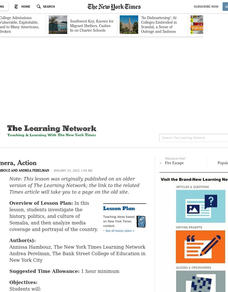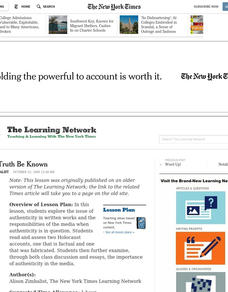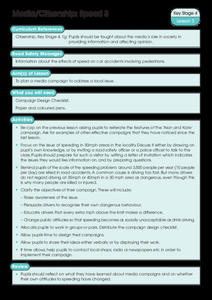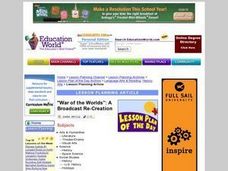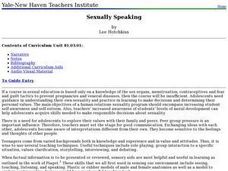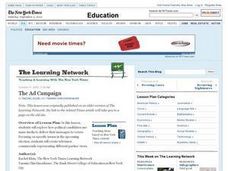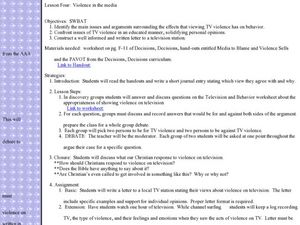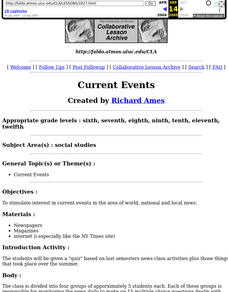Curated OER
Gandhi's Alternate View of Women: Changing the Face of Modern Media & Advertising
Eleventh graders analyze the violence of media and advertising on women, as well as Gandhi's views of women. For this women and media lesson, 11th graders Killing Us Softly and Tough Guise as an analysis of media and advertising and...
Curated OER
Media Views
Students create a collage of images depicting trends in the media. In this media lesson, students watch excerpts from several films, television shows, and commercials. Students compare and contrast media views...
Curated OER
Dogfighting Unit Lesson Five--The Media and Propaganda
Students consider the implications of dogfighting. In this character education lesson, students examine propaganda in advertising and then create their own anti-dogfighting advertisements.
Curated OER
The Generation Gap as a Result of Media Use
Learners compare digital natives and digital immigrants. In this media usage instructional activity, students read "The Generation Gap is Not New" and then compare today's generation gap with the generation gap of the 1920's.
Curated OER
Elements for Disaster Reporting
Students identify the elements of natural disasters and gain an understanding on how the media influences people's responses to disasters. In this natural disaster lesson plan, students study the impact of natural disasters, and the...
Curated OER
The Electric Hearth
Students examine popular media. In this media awareness lesson plan, students keep logs of their interactions with media and then write an essay regarding the data.
Curated OER
Advertising
Students explore the advantages/disadvantages of advertising and all it entails for the consumer. Public relations is examined in depth. In addition, media, slogans, promotion and elements of print and color are examined in detail.
Curated OER
Consider the Source
Students explain how to critically compare news reporting from around the world, focusing on coverage of the Taliban regime. They compare and contrast television and print media reporting on the issue.
Curated OER
Life, Camera, Action
Students investigate the history, politics and culture of Somalia. They analyze media coverage and portrayal of the country. They focus on the role of media in reporting on Somalia and the current debate over the film Black Hawk Down.
Curated OER
Let the Truth Be Known
Students explore authenticity in written works and the responsibilities of the media. They read two Holocaust accounts, one that is factual and one that was fabricated. They further examine, the importance of authenticity in the media.
Newseum
Reporting Part III: Staying Objective
The third and final lesson in the Reporting series tests young journalists' ability to be objective in reporting contentious topics. After brainstorming a list of contentious topics that interest them, the class selects one, and...
Curated OER
Evaluating Media Materials
Students demonstrate the ability to select and evaluate media materials. They demonstrate comprehension when listening and reading for literary experience, to be informed, and to perform a task. Students evaluate a fiction book based on...
Curated OER
Media/Citizenship: Speed 3
Students examine data about the effects of speed in car accidents. They create their own media campaign about safety while driving. They share their ideas with the class.
Curated OER
T.V. Smarts
Students research visual messages by completing a media quiz. In this television programming lesson, students identify the many programs and commercials which use sexual imagery to sell their program or product. Students discuss methods...
Curated OER
"War of the Worlds": A Broadcast Re-Creation
Why did Orson Welles' 1938 Broadcast of a adaptation of H.G. Wells' The War of the Worlds cause such a panic? To answer this question, class members listen to the original broadcast and research the panic that resulted. They then engage...
Curated OER
Sexually Speaking
Young scholars engage in activities designed to increase self esteem, self awareness and human sexuality. They engage in a variety of activities to encourage active participation, introspection, stating and examining values, gaining...
Curated OER
The Ad Campaign
Students explore how political candidates use mass media to deliver their messages to voters. Focusing on specific issues in the upcoming election, students create television commercials representing different parties' views.
J. Paul Getty Trust
Exhibiting Common Threads
Artists working in different media often explore the same themes—to model how these same themes weave their way through different forms of artistic expression, scholars analyze images by Dorothea Lange, identifying key themes in her...
Curated OER
Race and Gender in the Media
Young scholars analyze race and gender in the media. In this algebra lesson, students apply their knowledge of percents and ratios to determine the representation of race and gender in the media. They discuss and graph their data.
Curated OER
Violence in the Media
Students consider the impact of violence on television. In this media awareness lesson, students keep track of violent acts on television and write letters to network executives regarding violence on television.
Curated OER
Current Events
Here is an ongoing activity intended to build interest in local, national, and world news. The class is divided into four groups of approximately five students each. The groups are responsible for monitoring the daily news. They compose...
Curated OER
Watching the Clock: An activity to build media-savvy students
Young scholars analyze time constraints on broadcast news. They apply data collecting and data display skills. They identify the difference between news progams and the evening news.
Annenberg Foundation
Student Voices
Whether it's an election year or not, a unit on voting patterns and political campaigns will awaken the civic pride in your high school citizens. Divided into six parts, the curriculum covers various facets of an election, including...
Curated OER
Citizens and the Media / Lesson : 3 Compare and Contrast Daily Newspapers for fact, opinion and bias
Students compare and contrast a variety of daily newspapers in order to detect bias. They critically analyze the role the media plays in responsibly reporting government activities.








